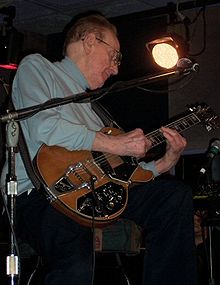Les Paul (June 9, 1915 – August 12, 2009)

Inventor of the Electric Guitar
(trom Wikipedia)
Paul's innovative guitar, The Log, built after-hours in the Epiphone guitar factory in 1940, was one of the first solid-body electric guitars. Adolph Rickenbacker had marketed a solid-body guitar in the 1930s and Leo Fender also independently created his own in 1946. Although Paul approached the Gibson Guitar Corporation with his idea of a solid body electric guitar, they showed no interest until Fender began marketing its Esquire and Telecaster models. Largely independently of Paul, Gibson president Ted McCarty and his team of engineers designed a solid body guitar to compete with Fender's Telecaster. Realizing that having a famous artist endorse the new guitar could increase sales, McCarty approached Paul with an endorsement opportunity. He was impressed enough to sign an endorsement contract for what became the Gibson Les Paul model, originally only in a gold-top version (official name: Les Paul Standard), and agreed never to be seen playing in public, or be photographed, with anything other than a Gibson guitar. According to McCarty, Paul's only contribution to the design of the guitar was the ill-advised trapeze tailpiece that appeared on the earliest models before being replaced by the McCarty-designed wraparound tailpiece. Les Paul disputed this version of the development of the guitar, claiming that he "designed everything on there except the carved top".
The arrangement persisted until 1961, when declining sales prompted Gibson to change the design without Paul's knowledge, creating a much thinner, lighter, and more-aggressive-looking instrument with two cutaway horns instead of one. Paul said he first saw the new Gibson Les Paul in a music-store window, and disliked it. Although his contract required him to pose with the guitar, he said it was not his instrument and asked Gibson to remove his name from the headstock. Others claimed that Paul ended his endorsement contract with Gibson during his divorce to avoid having his wife get his endorsement money. Gibson renamed the guitar Gibson SG, which stands for Solid Guitar, and it also became one of the company's best sellers.
The original Gibson Les Paul-guitar design regained popularity when Eric Clapton began playing the instrument a few years later, although he also played an SG and an ES-335. Paul resumed his relationship with Gibson and endorsed the original Gibson Les Paul guitar from that point onwards. His personal Gibson Les Pauls were much modified by him—Paul always used his own self-wound pickups and customized methods of switching between pickups on his guitars. To this day, various models of Gibson Les Paul guitars are used all over the world by both novice and professional guitarists. A less-expensive version of the Gibson Les Paul guitar is also manufactured for Gibson's lower-priced Epiphone brand.
On January 30, 1962, the US Patent and Trademark Office issued Paul patent No. 3,018,680, for an "Electrical Music Instrument."
share this article: facebook